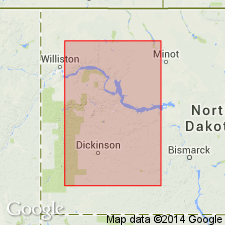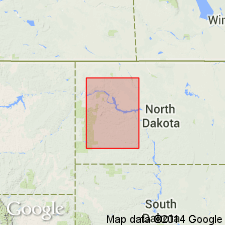
- Usage in publication:
-
- Taylor bed
- Modifications:
-
- Named
- Dominant lithology:
-
- Siltstone
- Marlstone
- AAPG geologic province:
-
- Williston basin
Summary:
Taylor bed (informal). Name applied to bed in upper part of lower member of Golden Valley Formation. Is the lateral equivalent of the Alamo Bluff lignite (informal), also assigned to the upper part of the lower member of Golden Valley at some localities. Consists of massive silicified siltstone or rarely marlstone 6 inches to 2 feet thick. Weathers into brown and gray blocks riddled with plant stem moulds. Forms flat-topped upland surfaces. Original distribution was patchy and discontinuous. Where Alamo Bluff and Taylor are missing a layer of carbon debris or carbonaceous paper shale marks the contact between the lower and upper members of the Golden Valley. Contact recognized by color contrast; lower member is dark-gray and upper member weathers yellow- to buff. Age is Paleocene (Clarkforkian). Report includes cross section. [Specific description of lower contact of Taylor bed or its areal extent not given.]
Named from exposures west of town of Taylor, Stark Co., ND (Williston basin).
Source: Modified from GNU records (USGS DDS-6; Denver GNULEX).

- Usage in publication:
-
- Taylor bed
- Modifications:
-
- Revised
- AAPG geologic province:
-
- Williston basin
Summary:
Taylor bed (informal). At some localities in western North Dakota (Williston basin), name applied to the uppermost beds (in uppermost carbonaceous zone) of the Bear Den Member (new), lower member (of 2) of the Golden Valley Formation. Taylor bed is chiefly a massive, gray-weathering, silicified siltstone of mostly silt-size quartz grains; thickness ranges from 18 to 60 cm. Contains many stem moulds and disseminated plant matter. Locally present are hard, aphanitic and laminated marlstones, 15 to 92 cm thick. Original distribution was probably patchy and discontinuous. Overlies unnamed siltstone or claystone in the carbonaceous zone of the Bear Den. Underlies the Camels Butte Member (new), upper member of the Golden Valley. Is considered a lateral equivalent of the informal Alamo Bluff lignite. Both Taylor and Alamo Bluff serve as valuable, persistent markers across the areal extent of the Golden Valley Formation. Relationship of Taylor and Alamo Bluff observed in the Taylor area, Stark County, North Dakota. East of Taylor, the Alamo Bluff transgressively replaces the Taylor bed. West of Taylor, the Taylor replaces the Alamo Bluff. Northwest of Taylor, the Alamo Bluff overlies the Taylor. Age is late Paleocene. Report includes cross sections, measured sections. [See also entry under Alamo Bluff.]
Source: Modified from GNU records (USGS DDS-6; Denver GNULEX).
For more information, please contact Nancy Stamm, Geologic Names Committee Secretary.
Asterisk (*) indicates published by U.S. Geological Survey authors.
"No current usage" (†) implies that a name has been abandoned or has fallen into disuse. Former usage and, if known, replacement name given in parentheses ( ).
Slash (/) indicates name conflicts with nomenclatural guidelines (CSN, 1933; ACSN, 1961, 1970; NACSN, 1983, 2005, 2021). May be explained within brackets ([ ]).

